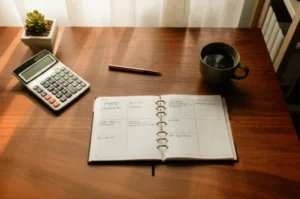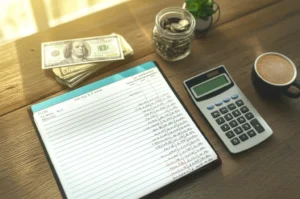Let’s be real: talking about “how to budget and track expenses” rarely sparks excitement. Most people imagine spreadsheets, boring rules, maybe even a whiff of guilt. But what if—hear me out—budgeting felt like an act of self-care? Not punishment. Not math class. Just a way to breathe a little easier at night because you actually know where your money’s going…and why.
If you’re here, you probably want quick, helpful advice, not a lecture. Here it is upfront: the fastest way to get control of your finances is to track your expenses for a month (yes, every coffee, every taxi, every random Amazon splurge), then build a budget around what you actually spend—not what you think you should spend. From there? Small tweaks, tiny wins, big sighs of relief. This guide lays out tools, strategies, and real talk. Ready?
Why Track Expenses
Why even bother with tracking and budgeting? Honestly—it’s about clarity. When you know where your money is disappearing, you get to decide if you like those choices or want to change them. It’s like shining a flashlight into your wallet and finally seeing what’s inside.
Real Benefits You’ll Feel
- Spot the leaks: Ever wonder how you “run out” of money? Tracking means you see those little leaks: subscriptions you forgot, daily snacks, impulse buys.
- Free up cash: Every pointless purchase you quit is cash you can throw at something that actually matters to you—whether that’s self-care, debt freedom, or a much-needed weekend away.
- Less stress, more control: Not knowing is exhausting. As you track, that “am I broke??” anxiety fades.
- Dreams become do-able: Whether it’s saving for a car or just not living paycheck-to-paycheck, tracking is the first step to plotting your way there.
But It’s Not Magic
Let’s set some honest expectations. Budgeting isn’t a fix for everything. It won’t make debt disappear overnight. It won’t increase your salary with a click. What it does give you is informed choice. That’s powerful but, yeah, also requires a little honesty (and a willingness to see some spending you’d rather ignore).
And a quick warning: if you’re using apps or digital trackers, always double-check their privacy policy. Not every “free” tool keeps your info totally private, and your financial data is valuable stuff. Pick tools you trust.
Budgeting Basics
You don’t need a finance degree or fancy jargon for “how to budget and track expenses.” Here’s the friendliest, step-by-step guide I know.
Step One: Know Your Real Income
Add up your take-home pay from work (after taxes), plus side gigs, sporadic cash, all of it. If your income is unpredictable, aim low—base your budget on the smallest amount you usually make. That keeps you safe, not sorry.
Quick Example:
Let’s say you take home $3,000/month after taxes and get around $250 from a side hustle. Plan on $3,000. If you end up earning more? Awesome. That’s extra cushion.
Step Two: Track Every Dollar For A Month
This part will probably surprise you (it sure surprised me the first time). There are a few ways to do this:
- Bank & credit card statements: Most of us let our bank do the tracking already. Take 15 minutes every few days to glance over transactions and jot them down by category.
- Receipts & notes: Prefer old-school? Toss every receipt in a box or snap a pic. Tally it at week’s end.
- Budget apps: Something like Mint (now on Credit Karma) or EveryDollar pulls your info in automatically. It’s quick, but remember the privacy note from above.
- Spreadsheets or pen-and-paper: There’s something powerful about seeing numbers YOU wrote down.
Try it for 30 days. You might gasp at how much you spend on take-out (hand raised here), but hey, awareness is the goal.
Manual vs. App Tracking
| Method | Pros | Cons |
|---|---|---|
| Apps (Mint, EveryDollar, YNAB) | Easy, automatic, quick overviews | Privacy concerns, can miss cash spending |
| Manual (Notebooks, Spreadsheets) | Full control, tracks cash, no sharing | Time consuming, needs discipline |
Step Three: Sort It Out
Put every expense into a category. Some folks do “needs,” “wants,” and “savings.” Others like to get more detailed: groceries, transport, restaurants, fun, bills, subscriptions…
This isn’t busywork—it’s insight. When you see numbers add up for “fast food” (or “impulse Amazon buys”—I see you), you realize where tweaks will add up fast.
Personal Budget Example
| Category | Amount | % of Income |
|---|---|---|
| Rent/Mortgage | $1,100 | 37% |
| Groceries | $400 | 13% |
| Utilities | $120 | 4% |
| Transportation | $200 | 7% |
| Dining Out | $150 | 5% |
| Savings | $300 | 10% |
| Debt Repayment | $250 | 8% |
| Entertainment | $120 | 4% |
| Other | $360 | 12% |
Your “personal budget example” doesn’t have to be perfect—just honest and useful.
Step Four: Pick A Method That Fits
Here’s a secret: there’s no “one right way” to budget! You get to decide what works in your world.
- Zero-based: Every dollar is a job. At the month’s end, every cent is assigned—either to an expense, saving, or debt payoff. Clean. Simple.
- 50/30/20: Based on your salary, use half for needs, 30% for wants, 20% for savings/debt. Great for “big picture” folks.
- Envelope system: Cash in envelopes, one for each spending category. When the envelope’s empty, that’s it ’til next month. (Works wonders if you overspend without realizing.)
- Pay yourself first: Flip the script—move money into savings or debt payment right after payday, then live on what’s left.
The right system is the one you’ll actually use. Mix and match if needed. No shame here.
Step Five: Tie Budgeting To Your Dreams
A budget isn’t just spreadsheets and limits—it’s a ticket to your goals, from small stuff (“stop overdrafting”) to big dreams (house! travel! early retirement!). Every choice counts. Want help mapping goals to a real-life plan? It’s worth checking out how can a budget help you reach your financial goals? for extra pointers.
Step Six: Review And Rework (No Guilt Allowed)
Life changes. You’ll overspend. That’s fine! What matters is checking in once a month: What did you forget? Any surprise bills? Celebrate what worked, tweak what didn’t, and keep moving forward.
Budgeting On Low Income
This is where budgeting gets gutsy and creative. Honestly, budgeting on a shoestring is tough, and anyone who says otherwise hasn’t done it. But even tiny shifts can add up, and tracking every penny matters more than ever. For in-depth strategies, I recommend how to budget money on low income, but let’s cover the essentials here.
What To Prioritize
- Needs first: Rent, groceries, medication, utilities. Wants can wait, and that’s okay. Sometimes, pausing just one treat gives you breathing room elsewhere.
- Build even a tiny emergency fund—$50 squirreled away is better than nothing.
Creative Stretching
- Is there a community resource, food pantry, or assistance you haven’t tried? No shame, only self-care.
- Negotiate everything you can: cell plan, internet, insurance. Ask—worst case, they say no.
- Try pantry week: Plan meals around what’s in your kitchen first, and only then shop for missing pieces.
Little Wins Matter
- Cancel a streaming service for just one month and stash the savings.
- Round up purchases to the next dollar and drop the change into savings (apps can help). Tiny bits add up!
It will feel tight. But every “small win” is a step toward more freedom and relief.
Tools & Templates
Find Your Tracking Style
Maybe you’re an app person. Maybe you just need pencil and a notepad. Try both and see which you stick with longest.
- App Aficionado: Mint, EveryDollar, Credit Karma’s integrated tool—they auto-categorize, spot recurring charges, and offer insights. Downside? You’re trading some privacy for convenience.
- Spreadsheet Power User: Build your own, or search for a free monthly personal budget example tracker (there are plenty, including from nonprofits). You’ll see every dollar flow by hand.
- Paper Loyalist: Printables from trusted organizations or just a well-loved notebook. Simple, zero data-sharing, and honestly, very satisfying.
Bonus: Set phone reminders to check your tracking once a week—consistency is 90% of success.
One-Page Budget Template
Here’s a quick starter:
- At top: Monthly income (be honest!)
- Then: List all fixed bills (rent, insurance, internet…)
- Next: Groceries, transport, kids, personal care, eating out…
- Last: Debt payments, savings, a little “buffer” if you can manage it
If you’d like a fuller template (and a little story on first-timer mistakes), pop over to how to make a monthly budget.
Stories From Real Budgets
It’s all well and good to talk theory, but what does “how to budget and track expenses” look like in the wild? Here are some honest-to-goodness scenarios.
Single Urban Professional—$2,800 Monthly Salary
She used to wonder: “Where did all my money go?” After one month of tracking, this person realized she spent $450 on take-out and $90 on two gym memberships—without using either one (it happens to us all!). She cut one gym and limited take-out to weekends. Those tweaks freed $300 per month for her travel fund. It made travel a reality in just four months. You can find more breakdowns and samples where you can learn how to make a monthly budget.
Young Family—Two Incomes, Big Dreams
“Impossible” was what they called saving for a house. By tracking daily spending, they noticed small, daily grocery store runs blew up their monthly total. Switching to once-a-week shops and cooking together cut waste and saved $120 a month. Not magic—just method and partnership.
Low-Income Hustle—Job Loss Came Fast
Imagine the panic after losing a job. For one reader, the panic became a plan: she listed essentials first, reached out for community aid, and tracked every expense by hand. The result? No, she didn’t “get rich”, but she stayed afloat and learned that budgeting wasn’t about shame, but simply surviving and planting seeds for later growth. Her wins (buying groceries with cash, calling the utility company for a payment plan) are victories worth celebrating.
Easy Checklist (Copy This To Your Phone)
- Track every cent for 30 days.
- Sort expenses: needs, wants, savings, debt.
- Pick a budget style you’ll use—don’t overthink it!
- Aim for one small goal at a time. Celebrate any win—yes, even tiny ones!
- Repeat every month. Adjust as your life changes.
Common Stumbles (And How To Dodge Them)
Forgetting Cash Buys
Coffee, parking meters, snacks at the gas station… Cash escapes, unless you jot it down at night or zap a photo of the receipt. Try a “cash-pocket” habit: keep all cash receipts in one spot—add them weekly.
Overwhelmed By Too Many Categories
Don’t make it a chore. Start simple: “needs” vs. “wants.” Add more detail only if (and when) you want to.
App Fatigue Or Privacy Jitters
Feeling burned by all the digital? Switch to a printable or spreadsheet. There’s power in your own two hands, and manual tracking works—sometimes even better.
Budget “Fails” Happen
No one gets it right every time. Go over? Pause extra spending, shuffle things around, and—most of all—ditch the guilt. Budgets are a guide, not a judge or a jailer.
Next-Level Moves
- Use 3-month averages: For stuff that jumps around (like utilities or groceries), average out three months’ spending to set a realistic budget number.
- Create sinking funds: Set aside a little each month for rare but costly stuff (car repairs, insurance premiums, birthdays), so you’re not caught off-guard.
- Automate what you can: Bills, savings, or even a recurring transfer into a “fun money” account.
- Seek help when needed: If debt or finances feel unmanageable, a trusted counselor or expert can help. You’re not alone.
And if you ever stumble across a stat, study, or story that changes your mind? That’s budgeting—always a work in progress, one step, and one choice at a time. (For example, according to financial education nonprofits, even 5 minutes a week looking at your spending can make a big difference read more.)
Conclusion
If you remember just one thing, let it be this: budgeting isn’t scary or rigid. It’s a kindness you give yourself, one line at a time. When you track your expenses, you see your life—habits, values, challenges—in real numbers. And you give yourself the chance to change.
Start today. Just track spending for 30 days, no pressure. Maybe try the one-page budget or check out an easy monthly budget guide. Set one goal. Celebrate when you stick with it—even a little. If life throws curveballs, adjust. And, most importantly, know this: there’s no perfect budget, only the one that works for you right now.
Got stories to share, questions, or tips that helped you how to budget and track expenses? Your experience could be the turning point for someone else. Let’s make budgeting not just another chore, but a tool for freedom, calm, and, dare I say, a little joy along the way.













